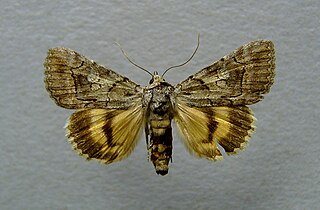
Catocala is a generally Holarctic genus of moths in the family Erebidae. The genus was erected by Carl Linnaeus in his 1767 12th edition of Systema Naturae. The moths are commonly known as underwing moths or simply underwings. These terms are sometimes used for a few related moths, but usually – especially when used in plural, not as part of a species name – they are used to refer to Catocala only.

What a Mess! is a 1995 farce comedy film of late post-Perestroyka era directed by Vladimir Menshov. The movie satirizes chauvinism, antisemitism and other ethnic tensions in the 1990s Russia. Valery Garkalin plays multiple roles as identical twins who were raised believing they belong to different cultures and races and used to look down on each other's.

Olepa schleini is a moth of the family Erebidae first described by Thomas J. Witt, Günter C. Müller, Vasiliy D. Kravchenko, Michael A. Miller, Axel Hausmann and Wolfgang Speidel in 2005. It is only known from the coastal regions of Israel, but is probably an alien species, as its food plant is not native to Israel. The species was discovered in 2005 and is named for the entomologist and sculptor Yosef Schlein. The larvae only feed on Ricinus communis, which is curious because this plants produces the natural insecticide ricin.
Catocala lesbia is a moth of the family Erebidae first described by Hugo Theodor Christoph in 1887. It is found in the Middle East, in regions without severe winters. In Turkey, south-east of the Anatolian Plateau, in oases and desert foothills in Iraq, south as far as the Sinai and Egypt. In Israel it is found in the Jordan Rift Valley and Negev.

Catocala puerpera is a moth of the family Erebidae first described by Michel-Esprit Giorna in 1791. It is found in Mediterranean and sub-Mediterranean areas of the Near East and Middle East and in North Africa.

Catocala conversa is a moth of the family Erebidae first described by Eugenius Johann Christoph Esper in 1787. It is found in the Mediterranean zone and parts of the sub-Mediterranean zone.
Catocala hymenaea is a moth of the family Erebidae first described by Michael Denis and Ignaz Schiffermüller in 1775. It is found from the Middle East to western Asia.

Catocala diversa is a moth of the family Erebidae first described by Carl Geyer in 1826. It is found in Spain, south-eastern France, Italy, the Balkans, European southern Russia and Israel.

Catocala eutychea is a moth of the family Erebidae first described by Georg Friedrich Treitschke in 1835. It is found in the eastern parts of the Mediterranean, especially the Balkans.

Catocala separata is a moth of the family Erebidae first described by Christian Friedrich Freyer in 1846. It is found in the Balkans, the Mediterranean part of southern Turkey and the Levant.
Catocala editarevayae is a moth of the family Erebidae first described by Vasiliy D. Kravchenko et al. in 2008. It is known only from Jordan and Israel.
Catocala puerperoides is a moth of the family Erebidae first described by Vasiliy D. Kravchenko et al. in 2008. It is restricted to more northern parts of Iran, reaching the southernmost distribution in southeastern Zagros, provinces Azerbayejan-e-Sharqi, Mazandaran, Tehran, Lorestan, Khuzestan and Kohkiluye va Boyer-Ahmad.
Olepa clavatus is a moth of the family Erebidae first described by Charles Swinhoe in 1885. It is found in India.
Olepa toulgoeti is a moth of the family Erebidae first described by Orhant in 1986. It is found in southern India.
Olepa koslandana is a moth of the family Erebidae first described by Orhant in 1986. It is found in India and Sri Lanka.
Olepa anomi is a moth of the family Erebidae first described by Orhant in 1986. It is found in Sri Lanka.
Olepa duboisi is a moth of the family Erebidae first described by Orhant in 1986. It is found in Sri Lanka.
Olepa kakatii is a moth of the family Erebidae first described by Orhant in 2000. It is found in north-eastern India and Assam.
The 1951 Soviet Cup was an association football cup competition of the Soviet Union.







